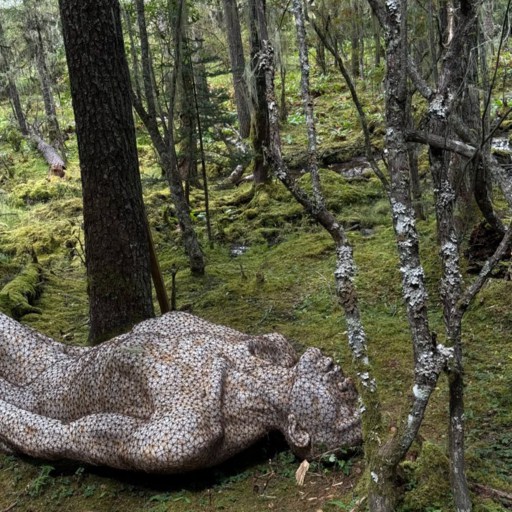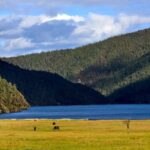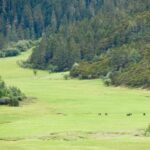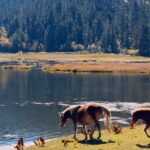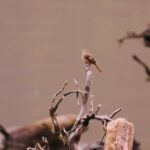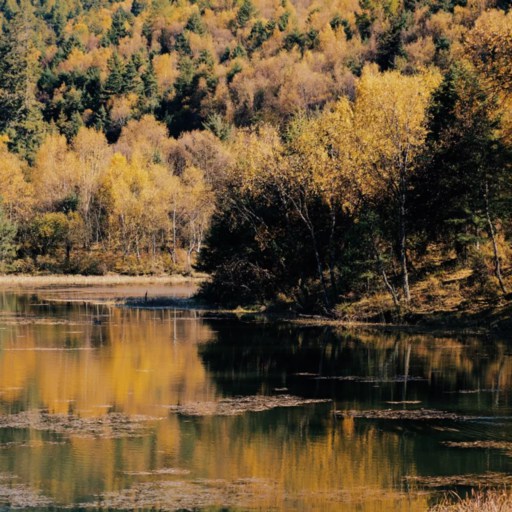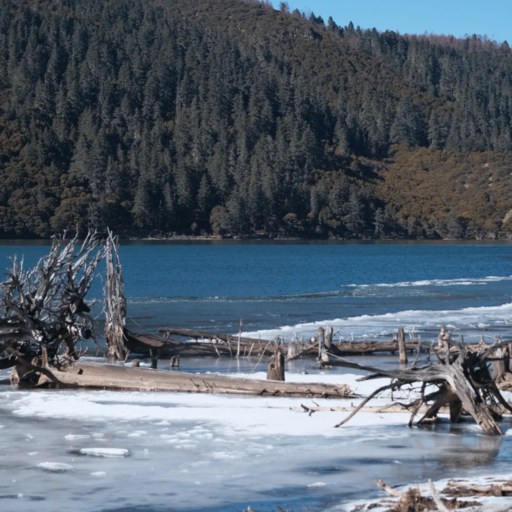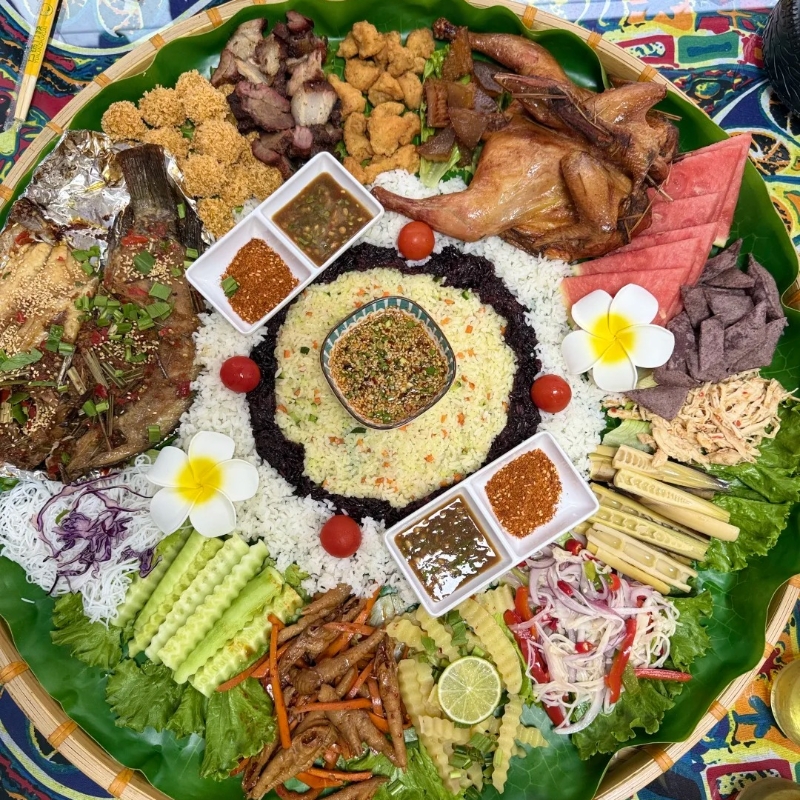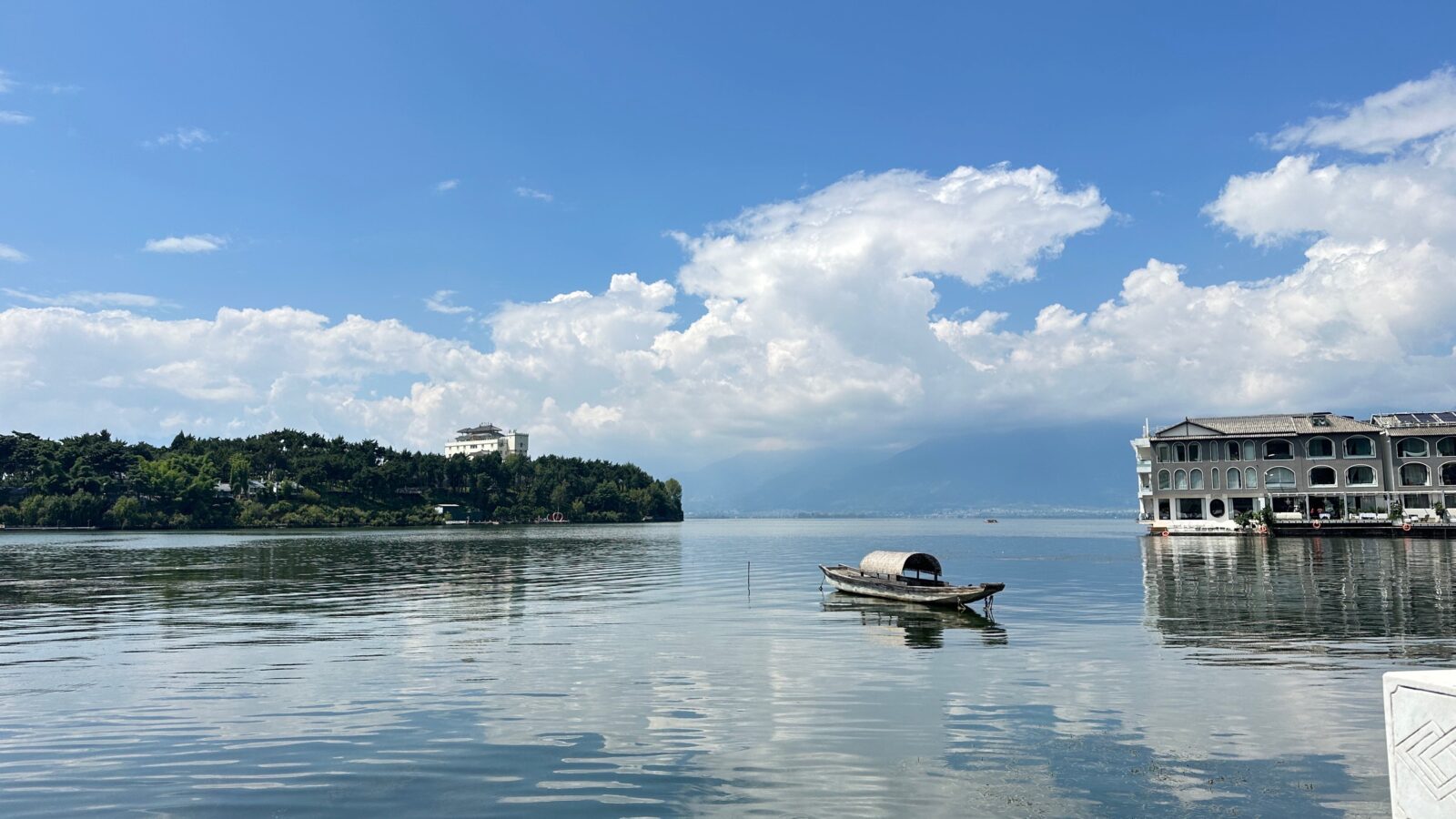
Potatso National Park Yunnan
Potatso National Park Yunnan is around 40 minutes from Shangri-La’s old town, but it is another world altogether. You pass noodle stalls and souvenir shops in one breath, but are sucking in the thin, pine-scented air 3,500m above sea level in the next. Locals still refer to it as Pudacuo, although the signs don’t seem to agree. Inside, it is lakes, yaks, wooden walkways winding through meadows, which change from gold to green in one hour. It is not large.
Nearer 190 RMB for entry and shuttle buses, but timing is important. The weather changes quickly, and if you go in late, you will cover the best parts in mist. Most people take the clockwise route, Shudu Lake, Militang Pasture, then Bita Lake, and I reckon that is the sweet part. Miss it and you will most likely regret it.
Quick Facts about Potatso National Park Yunnan
| Location | 22km east of Shangri-La, Diqing Prefecture, Yunnan, China |
| Altitude | 3,500–4,200m |
| Entrance Fee | 190 RMB (includes shuttle bus) |
| Opening Hours | 8:00 a.m.–5:00 p.m.(Shudu Lake trail closes at 4:30 p.m.; Bita Lake boardwalk closes at 4:45 p.m.) |
| Best Visiting Months | May–October |
| Main Attractions | Shudu Lake, Bita Lake, Militang Pasture |
| Official Name | Pudacuo National Park (Potatso National Park) |
| UNESCO Status | Part of “Three Parallel Rivers” World Heritage |
Why Potatso National Park Yunnan Feels Different from Anywhere Else
- Art Exhibition in Potatso National Park Yunnan
- River in Potatso National Park Yunnan
Between Heaven and Highlands — The First National Park of Mainland China
Potatso National Park in Yunnan doesn’t hit you with huge monuments or choreographed shows. It’s quieter than that—almost restrained, like a place that knows it doesn’t have to try. The air is thinner than you expect; my first few steps felt like walking in light syrup. At this Potatso National Park altitude of around 3,500 to 4,200 meters above sea level, even laughter comes out slow. But the clarity of the lakes makes up for every breath—you can literally see the clouds mirrored in Shudu Lake, like the sky decided to take a rest on water.
TripAdvisor users seem to agree with this: they have rated it high for “unreal reflections and perfect walkways.”The ticket price of 190 RMB feels a little high if the weather goes sour—which, here, it often does. I remember one June afternoon when fog swallowed the whole trail; for a moment, the wooden way looked to be leading nowhere. But this strange aloneness is part of the appeal of the park. You don’t come here for the perfect weather—you come for that quiet, in-between feeling.
Opened in 2007 as the first national park on the mainland of China, Potatso was meant to set a standard: low-impact tourism, shuttle-only transportation, no trash zones. Surprisingly enough, it works. You walk on elevated planks while yaks graze below, and the damp-pine smell mixes itself with yak dung and wild herbs. The silence is never complete; there is always the creaking sound of the flooring and a far-away bell from some grazing beast. Every few turns a sign comes up in both English and Chinese—some of them mistranslated (“Protect Wild Elk. Don’t chase them for amusement.”). Someway, this makes the place feel more real.
Local Tibetan Beliefs and How They Shape the Landscape
Its local name is Pudacuo National Park, a vague term that means“the land of the gods.”And one can easily believe the local people. Around Bita Lake the Tibetans walk in a clockwise direction, mumbling prayers under their breath and spinning small hand wheels in their fingers, without regard for the tourists, who seem to be of little moment. Once a ranger half jokingly remarked to me,“If you walk in a counter-clockwise direction, you will get lost among the fog.”I did not try it.
The rhythm of the park belongs to faith. Wooden stupas peer out from between rhododendrons, and heaps of mani stones can be observed at every crossing of a stream. Even the yaks seem to move more slowly in this park, feeling, I suppose, something inscrutable and strange. It is not hard to believe the local story that the lakes were once mirrors presented to the gods, and at certain times in the afternoon when the sunlight breaks through among the mist it looks as if it all could very easily be true.
So if there are more attractive parks in China, there are few parks that involve you so directly. Potatso is not polished; it lives. You will find, if you listen long enough, that it nearly whispers back.
What to See and Do inside Potatso National Park Yunnan
Shudu Lake — Reflections, Wooden Trails, and Yak Bells
On the northern flank of Potatso National Park Yunnan, Shudu Lake is the first stop for most after the little shuttle bus creeps through the narrow pine valley. The lake lies wide and still, almost lazily but, up you get when you begin walking, it is ever changing. The board walk creaks at every step; the odour of resin and wet grass is in the air. It is at a height of about 3,705 meters that most visitors feel the altitude for the first time, it takes the lungs a little tight, the cameras go slow, everybody naturally talks a little more softly.
The lake of Shudu mirrors the mountains so perfectly that people pause in the middle of a sentence to take a second look. One travelwr who wrote on "Trip Adviser" said: "I never knew that water could be so quiet." From the further shore sound the yak bells; little by little they come from a distance, breaking in terminal strength with the hum of the shuttle engines. Following the wooden track in a clockwise direction the distance of the circuit is about 3·3 km., and halfway round a small pier finds favour with the local guides who city owners of the rowboats hired to them by the locality provided the weather permits. The price holds between ¥50 and 70 per head but this varies from season to season.
A local guide natural consequence called out to me, "Walk not to close to the edge after rain, as at these times the planks are very slippery." I slipped my self nearly on one occasion, so he is a judge. From the above remark, it is vitally important to look out for the shoes the tourist wears, having a close grip, and also to provide himself with a zip leather bag in which his mobile telephone can be contained, inasmuch as the fog comes on one before one is aware of it.
Bita Lake — “Mirror of the Plateau” with a Local Legend
Farther south yet the shuttle disburdens you at Bita-Lake, the sole essence of the park, and where the natives speak about. Now the word Pudacuo-National-Park Yunnan begins to have meaning, it looks a little like troubles. The water lies like glass, and the high spruce tress lean over, so sharply is the reflection that they seem double. The Tibetans call Bita the "mirror of the plateau," and there is a story to the point: a goddess dropped her bronze mirror there after having a disagreement with the sky, and it broke and formed the deep blue basin now to be seen.
Visitors like it, not for its worth, but because of its picturesqueness, but all do not note that it is climbing into the higher reaches of Mt. La, 3900 meters high. I found a sensation near the lake pavilion. Incense was burning about a small shrine. “Travel round in a clockwise direction,” said an old monk, “for luck and safety.” Most all follow this route, which leads around the wooden walk of the lake.
The walk will take some two hours and a half to accomplish, but results vary with the speed of the walker. Best reflections are before 10. a. m., or just pre sunset—at least the TripAdvisor reviews think so. At noon the glare is silver white and the charm is lost. It costs nothing extra for this space, as the 190. RMB ticket covers this park, and for what it is worth, no additional payment is required, but drink lots of water. The air was going on a bender, but even in summer it stabs straight at you.
Militang Pasture — Summer Blooms and Open Skies
Milityang Pasture lies between the two lakes, a vast stretch of highlands in which it is hard to say where the road is. Of this stretches through the middle of Potatso National Park Yunnan, which is mostly passed by in great haste by tourists on their rush between lakes, a great mistake. In bright sunshine parts of the pasture case gleam yellow buttercups, crimson rhodondendrons, dark shaggy long haired yaks, feeding happily. You can hear their tails softly swish if the pace is slower.
I have been once just after a thunder-storm. The air is still suggestive of iron in scent and the little puddles mirror the blue of the skies, miniature lakes. A mob of children of the village were herding goats and he laughed when I got my rented rain coat caught on a fence. Which is just the kind of raw sensation that is got not at super-refined entertainment. The height is about 3800 metres and it is flatter than the lake tracks, so families or anybody in trouble can get polension of the rarefied air easier. Bring your sunburn medicines for the villagers say "the sun here does not burn, it stings," and they are all right. The Trip.com boosters speak of this also as the best picnic ground in the park but there are no cafes, merely benches and prayer-flags snapping in the wind.
Hidden Corners — Lesser-Known Spots and Photo Points
Most maps indicate only the main attractions, but look carefully at the map of Potatso National Park — or just ask the shuttle driver — and you will find quiet gems. One is a small viewpoint beyond the Militang rest stop, marked only by a wooden sign that reads “观景台” in fading characters. But hardly anybody stops here, and yet it looks down on both lakes at one time, between the pines. There I saw a rainbow in the making after a drizzle, half-fog, half-light. No filters were needed.
Another hidden trail starts behind the visitors’ rest house, where a rough cartroad leads to a bog of white poplars. It is not on the official trails, but the natives use it for bird stalking, and you may see black-necked cranes there if you are patient. A ranger told me, “They begin to appear about May, if you are quiet enough.” He didn’t know — neither did I — but that uncertainty makes it all feel real.
Changes of weather here come quickly, and that is part of the fun and the risk. Many of the TripAdvisor reviews mention a sudden rain, and one man actually wrote: “We walked into a cloud. Literally.” It is true. The park seems to pulsate to its own rhythm. One hour you are sweating under a clear sky, and the next you are Polishing up the mist from the camera lens. By the time the shuttle hums back towards Shangri-La, you realize that half of the charm of Potatso lies in these unregimented moments, these wind sounds, these echoes and the silence that lingers after you have left.
When to Visit Potatso National Park Yunnan — Weather, Seasons & Altitude Tips
- Spring of Potatso National Park Yunnan
- Autumn of Potatso National Park Yunnan
- Winter of Potatso National Park Yunnan
Spring & Summer — Rhododendron Trails and Mild Rains
Anyone who has been will tell you Potatso National Park Yunnan is at its best from April to August. The sides of the hills are packed with rhododendrons – reds, purples, and strange shades of coral called “yak pink” by the locals. The trails smell faintly of earth and pine; trickles of water run across the boardwalk. The weather is quick to change. At noon the sun is shining brightly; an hour later it is drizzling. Take a light raincoat and waterproof shoes, particularly if you have the photo bug and would like to take any near Shudu Lake. After a rain the reflections there are surreal.
TripAdvisor reviews in this season show that everyone agrees to the greater number of people, but it is worthwhile. One said “We got drenched half way, and the light after the storm was terrific.” I know how that is. The fog settles in low, and when there is a break of sunshine, it appears as if some one turned the world on again.
Autumn — Golden Forests and Thin Air
Air From the last of September to the early part of November the park becomes amber and gold. The forest near Bita Lake turns into a painter’s mixture of ocher and russet and every breath of wind sends needles swirling over the paths. It is at this time that the potatso national park altitude recalls to you its serious side. At the top side of about 4,000 meters the air bites sharply, and it seems as if the photo stops are a little workout.
If you’re curious how the rest of Yunnan feels during this season, check how spring transforms the province’s mountains and lakes in our Yunnan Weather & Travel Guide.
Also it is a photographer’s dream. The early morning light catches the water at a low angle and returns you that coppery period of light that you cannot get in any other season. The reviews speak of the thinning out of the crowds after the first of October, but the shuttles are also of rare occurrence. The locals told me it is the “quietest time,” and this is true, except for the sound of the crunching leaves underneath your feet.
Winter — Frozen Lakes and Solitude
Wilderness By December Potatso is somber. The lakes freeze into sheets of silver; the walks take on a glaze. Some people avoid it on that account, but others, myself included, like the silence. The thermometer sinks to a minus of 10° C, but the sunny days (the sun always shines here) are not too unpleasant—are crisp and clean and almost medicinal. One writer on TripAdvisor said, “It was only myself and three yaks.” They were not exaggerating; you could almost have the park to yourself. Only it is better to be sure of the shuttle car schedules, because in the winter they are different.
I arrived once at Bita after a snowstorm and the planking was mummified in snow. My breath looked like smoke. It was so quiet that I could hear the ice giving way under the face. There is no other park in Yunnan that possesses that kind of quietness.
High-Altitude Survival Tips for First-Timers
The body will complain before you do at this high altitude. The park is located at a height of from 3,500 to 4,200 meters. I remember my first ascent up a little hill, and I had to stop in the middle of each sentence to get breath. The natives told me to sip water every few minutes and avoid alcohol the first day. They were right. You can get oxygen bottles at the visitor’s center, five marks a day, but most tourists do not need them if they take it easy.
If you’re curious about how to behave politely when talking with locals or joining a family tea session, learn a few dos and don’ts first in our guide to Chinese Etiquette and Local Customs.
The other necessities? A sunburn preparation. A hat. And clothes in layers. While the sun is not fierce, the ultra-violet rays are. Rain coats may be bought at every entrance, but I would carry my own, as the showers appear out of nowhere. If you are from the lowland cities like Kumming, I would stay a day in Shangri-la before going out, as you are well repaid when the air grows thin and the world feels for a moment impossibly wide.
FAQs about Potatso National Park Yunnan
Q: How do I get to Potatso National Park from Shangri-La?
It’s roughly 22 km southwest of Shangri-La. A taxi costs about ¥100 one way, or you can join a local tour bus from the old town for around ¥60–80. The drive takes 40–45 minutes through winding pine forests. Roads are well paved, but start early—fog can slow you down after noon. Most visitors prefer hiring a driver so they can stop for photos along the way.
Q: What is the Potatso National Park entrance fee?
Tickets cost ¥190 per adult, including the shuttle bus between Shudu Lake, Militang Pasture, and Bita Lake. Children under 1.2 meters enter free. You can buy tickets directly at the entrance or through Trip.com, which often offers combo passes with nearby attractions. Keep your ticket—it’s checked at each stop inside the park.
Q: Is it safe to visit Potatso National Park at high altitude?
Yes, but take it slow. The park’s elevation ranges from 3,500–4,200 meters, and mild altitude reactions—headache, dizziness—are common. Drink plenty of water, avoid alcohol on arrival, and rest if you feel light-headed. Oxygen bottles are available for rent at ¥50/day near the entrance. Most healthy travelers adjust within an hour or two.
Q: When is the best season to visit Potatso National Park Yunnan?
May to October is ideal. Spring brings blooming rhododendrons, summer offers clear reflections on the lakes, and autumn glows gold. Winter has frozen lakes and almost no crowds but limited shuttles. According to TripAdvisor reviews, July and September have the best balance of scenery and accessibility.
Q: Are there English signs and guides inside Potatso National Park?
Mostly yes. Maps and direction boards are bilingual, though translations can be funny at times. A few rangers speak basic English, and recorded bus guides play in both languages. If you want in-depth explanations about flora or Tibetan culture, hiring an English-speaking local guide from Shangri-La (around ¥200–300) is worth it.
Q: What’s the difference between Potatso and Pudacuo National Park?
None—it's the same place. “Pudacuo” is the transliteration of the Tibetan name, while “Potatso” is the older English spelling. Both refer to the same park inside the Three Parallel Rivers World Heritage Site. Maps and online listings use both names interchangeably.
Q: Can I book Potatso National Park tickets online?
Yes, through Trip.com or Ctrip, where you can choose date-specific passes. Online booking avoids queueing, especially on weekends. You’ll need your passport number to complete the purchase. Show the confirmation QR code at the gate—no need to print.
Q: What should I pack for a day trip to Potatso National Park Yunnan?
Layered clothing, sunscreen, and a waterproof jacket are essential. Weather shifts quickly, even within an hour. Bring water, snacks, and a power bank—outlets are limited inside. If you plan long walks, wear shoes with grip for wet wooden paths. Don’t forget cash or Alipay for souvenirs and tea near the visitor center.
